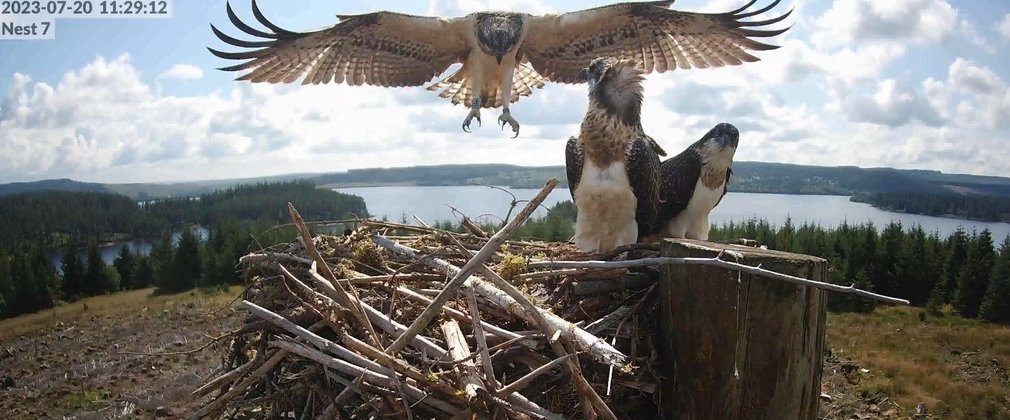
Up, up and away! Kielder’s rare osprey chicks now airborne
The last of this year’s osprey chicks have successfully taken to the air in Kielder Water and Forest Park.
Forestry England can reveal that 11 youngsters have now fledged after taking their inaugural flight. It’s another milestone for the Kielder Osprey Project.
The endangered bird first bred in the 63,000 hectare Northumbrian forest in 2009 after a gap of at least two centuries. Since then an astonishing 114 chicks have fledged over 15 consecutive years of breeding.
Joanna Dailey, osprey co-ordinator with Forestry England, explained:
“It’s a big boost to conservation efforts given that the species was extinct in England for almost all of the 20th century. Because we have high definition cameras on many of the nests we can follow the story as chicks pluck up courage to take their first flight. Tell-tale signs include wings being energetically flapped and hovering. It’s amazingly satisfying seeing them take to the air and do a circuit of their tree-top nest.”
Juvenile ospreys may have earned their wings, but the hard work continues for the parents. Chicks stay near the family nest and still need feeding. Perfecting their flying skills is the next stage in growing up and then they must learn to hunt. Plenty of body fat will be needed as within weeks they will begin a 3,000 mile journey to sub-Saharan Africa.
Duncan Hutt, Director of Conservation at Northumberland Wildlife Trust, added:
“It’s no accident ospreys have returned to Northumberland in such strength. It’s the result of long-term planning, team-work and sensitive habitat management. It’s a magnificent bird which is back where it belongs.”
Gary Storey from Northumbrian Water said:
"With so many ospreys on the wing, August is the best time to observe them fishing over Kielder Water. Tower Knowe visitor centre is a great vantage point and our partners Wild Intrigue are leading unique Osprey watch cruises on Northumbrian Water’s aptly named Osprey Ferry twice weekly on the reservoir.”
Eight of the young ospreys have also been fitted with unique rings to help identify them in the future. Three more were born on a wild nest in the forest which wasn’t safe to climb so ringing was not possible.
In part due to the wet weather fledging this year has been up to two weeks later than normal.
The Kielder Osprey Project is a partnership between Forestry England, Northumbrian Water, Northumberland Wildlife Trust and Wild Intrigue.
Notes to Editor
1. Wild Intrigue cruises aboard the Osprey Ferry take place at 5.30pm on Wednesdays and Saturdays. Booking is required. The Tower Knowe osprey cabin is currently open all week.
2. Ospreys were once distributed widely throughout the UK, but persecution resulted in the species becoming extinct as a breeding bird in England in 1847 and in Scotland in 1916. Because of their historical decline they are an Amber List species. Chicks fledge about seven weeks after hatching and a fully grown adult can have a wingspan of over five feet. The bird normally breeds for the first time when it is aged between four and five years old. Males in particular have a strong instinct to return to the place of their birth. To find out more about Kielder ospreys visit the blog at https://kielderospreys.wpcomstaging.com which also has the latest images.
3. Forestry England manages and cares for the nation’s 1,500 woods and forests, with over 363 million visits in 2021/22. As England’s largest land manager, we shape landscapes and enhance forests for people to enjoy, wildlife to flourish and businesses to grow. We are continuing the work we have already started to make the nation’s forests resilient to climate change and by 2026 we will:
• create at least 6,000 more hectares where we integrate wilding activities in our productive forests.
• increase the diversity of visitors to the nation’s forests and have one million hours of high-quality volunteer time given to the nation’s forest
• plant at least 2,000 hectares of new, high quality, predominantly broadleaf woodlands
For more information visit forestryengland.uk. Forestry England is an agency of the Forestry Commission.
Media contact
Jonny Winter on 07551 094332
